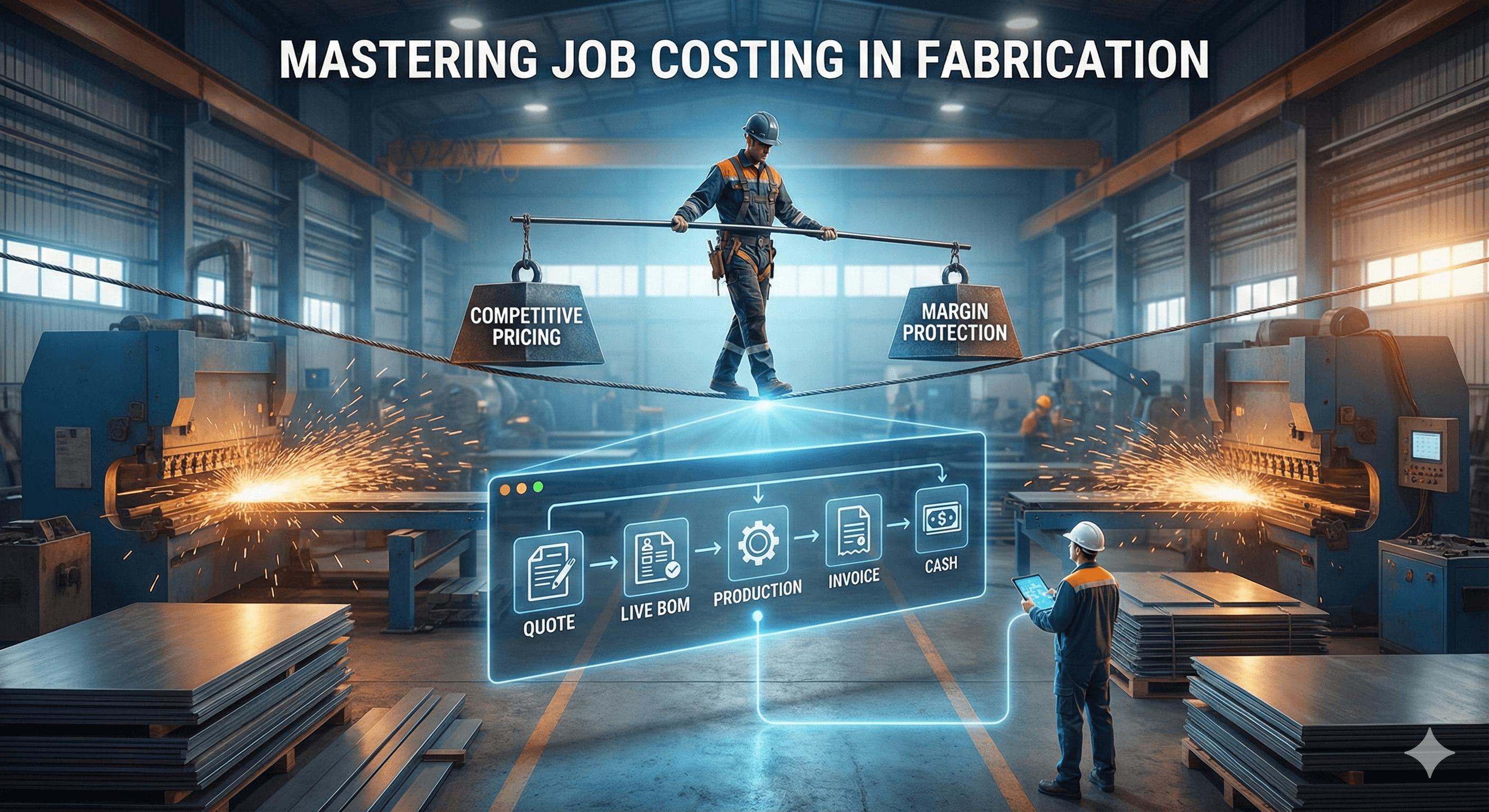There is no timeline for replacing your ERP (enterprise resource planning) software because every company is different. However, there are telltale signs that you might be ready for an upgrade.
In manufacturing, like any industry, you don’t always know what you don’t know. You might be maintaining positive cash flow—but only just. You could be meeting all your customers’ deadlines—but only if your team works overtime. There may be other hidden costs weighing down your business too, like the build-up of excess and SLOB (slow moving and obsolete) inventory in your warehouse.
Sometimes it takes an incident—like a missed deadline or a cash flow crisis—to prompt fabricators to consider how they can move from being reactive to proactive. A review of processes, equipment, skills and technologies can drive improvements that reduce costs, improve margins and enable growth.
A modern ERP is key to achieving this because it supports data-driven decision making and automation. It allows you to handle more orders and complex assemblies, while maintaining quality standards. It also gives you the features and capabilities you need today, with the option to add more as you need them.
In this article, we’ll look at the signs you’re ready to replace your ERP and how you can do it with minimum disruption.
What we’ll cover:
Do companies still use ERPs?
8 signs you need to replace your ERP
Replacing your ERP: How to overcome the challenges
Benefits of replacing your ERP
Choosing a reliable ERP provider
Do companies still use ERPs?
ERPs have been around for a long time—as far back as the 1960s/’70s to be precise. So you may be wondering ‘are ERPs still relevant today?’. The short answer is yes. Research suggests the market is expected to grow by 3.3% up to 2030, with the U.S. generating the highest revenue.
Over the years, ERPs have become more advanced, evolving from tools to support manufacturing processes to becoming a central system used by procurement, sales and finance teams, along with production. Modern ERPs are more user friendly, offer better insights and can be integrated with other systems to improve efficiency and decision-making.
8 signs you need to replace your ERP
You’re ready to scale
Forward-thinking manufacturers know they’ll run into trouble if they don’t have the right metal fabrication ERP software to fulfil orders and maintain quality as they scale up. A period of growth can expose the cracks in your business if you rely on manual processes. An ERP helps you to streamline and automate tasks, while giving you visibility of all your business operations, which reduces error, duplication and delays as you take on more orders.
Disconnected systems
Disconnected systems are a big problem for businesses. Data sits in silos and your teams may end up duplicating tasks or having to ask their colleagues for information. Worse still, unless you have complete oversight of procurement, production, inventory, sales and finance, your decision-making is going to be limited. A modern ERP should be at the core of your business, connecting different departments. It gives them the data they need to make better decisions, at both a strategic and everyday level. Your ERP should also integrate seamlessly with the other provider systems like QuickBooks and FedEx.
Poor communication
In a busy manufacturing environment, it’s easy for messages to be misheard or misinterpreted, leading to errors, wastage, unnecessary duplication, and even product recalls and safety issues. An ERP solves that challenge by making all information, specific to a person’s role, available in one place. They’re presented with clear logical workflows and actions that enable them to get the job done efficiently and accurately.
Missed deadlines
Just one missed deadline can be felt across the supply chain, damaging both customer satisfaction and potentially your reputation in the industry. Being able to deliver on-time, in-full (OTIF) is critical but it can be a challenge because of the inefficiencies we’ve highlighted above. Since an ERP gives you full visibility of your production schedules, resource availability and customer orders, you can anticipate any bottlenecks or delays due to materials shortages and take steps to address them.
Manual data entry
With staffing shortages common in many manufacturing businesses, do you really want them to spend their time manually entering data onto a system? This tedious task may lead to silos, errors and inconsistencies too, which makes it hard to make effective decisions.
Lacks automation
Automation saves time and improves accuracy—and those who embrace it strategically can improve their competitiveness. Your ERP should support everyday automations like work order creation, reporting and payments, which translate to hours saved over a week.
Your team doesn’t use it
One of the biggest signs you’re ready for a new ERP is lack of staff engagement. If your current system is clunky and difficult to use, employees will look for other ways of doing things—often manually, using spreadsheets. This increases the chance of error and miscommunication. Critical information won’t be available to staff when they need it and you won’t be able to provide an audit trail for customers.
It’s no longer supported
Even if your current ERP has served you well for 10 years you could be missing out on the functionality, security features, integration and seamless user experiences that new systems offer. Unsupported technologies require more maintenance and could pose a security risk to your business’ networks. There’s a missed opportunity too, since old systems don’t provide the up-to-date insights that drive improvements.
Replacing your ERP: How to overcome the challenges
Even though an ERP can offer significant benefits, metal fabricators are still often nervous because it’s a significant investment in time and money. Those who’ve been stung in the past might understandably ask, ‘Why do ERP implementations take so long?’ or even ‘Why do most ERP systems fail?’.
However, there are ways you can reduce the time it takes to deploy your ERP, manage stakeholder expectations and see the value from your investment as soon as possible.
| Challenge | Solution |
| High costs | Undertake a market cost analysis, comparing what different vendors offer but also what features and support you can expect. Getting the balance right is critical. You don’t want to pay for features you don’t use. Equally, you don’t want to have to invest in costly customizations or even a new ERP if the software doesn’t serve your future needs. |
| Long deployment times | It can take months for an ERP to be fully up and running but that doesn’t mean it cannot deliver value in the meantime. Setting milestones in your roadmap will reassure stakeholders that deployment is on track and you can test it on some tasks, making improvements before rolling it out on a bigger scale. |
| Staff training and onboarding | Run dedicated training sessions and get staff familiar with using the software early on. Create a pilot group of users who can flag up any issues, as well as super users or champions to advocate for the software and answer any questions from the wider team. |
| Operational disruption | Rolling out a completely new system at once is risky when you’ve got to fulfil customers’ orders. Start adding a small number of tasks to your new system while retaining your old one as a back up. |
| Integration issues | New ERPs are designed to integrate easily with other software, so check what your vendor offers and work with them to ensure they work. |
| Post implementation | Choose a vendor that offers comprehensive support and knows your industry well so you can |
Benefits of replacing your ERP
Technology is advancing all the time—and modern ERP software is no different. Replacing your ERP means you unlock new features and capabilities that improve the overall efficiency and productivity of the business. As we’ve seen, the move doesn’t have to be disruptive, as long as it’s carefully planned with stakeholders being kept fully informed, and staff trained and onboarded with minimum disruption.
Choosing a reliable ERP provider
There are numerous ERPs on the market but how do you know which is best for your business? A lot depends on your budget, size of your operation and your growth ambitions. As our recent blog outlines, some are more affordable, some more suited to start-ups and some best for customization. Choosing a product like MIE Trak Pro, a metal fabrication ERP, means you benefit from features and support that are specifically tailored to your industry.



